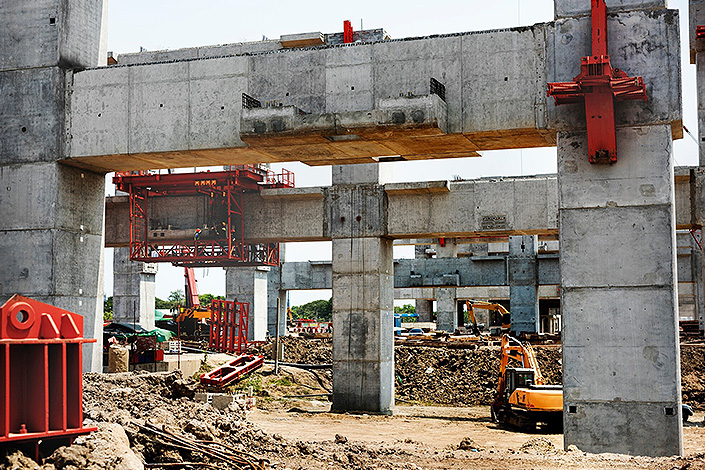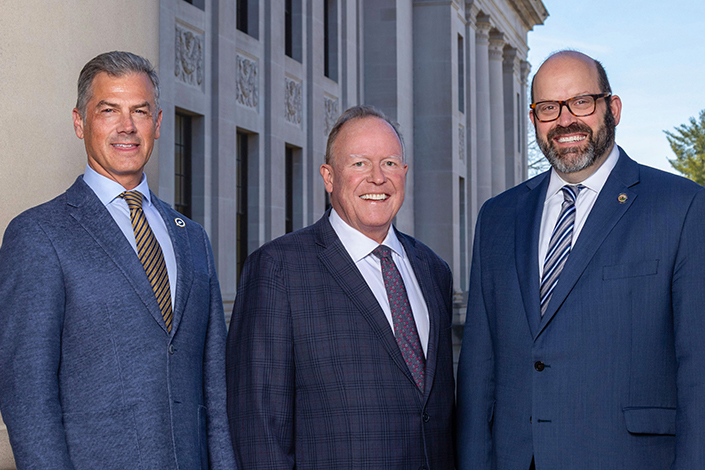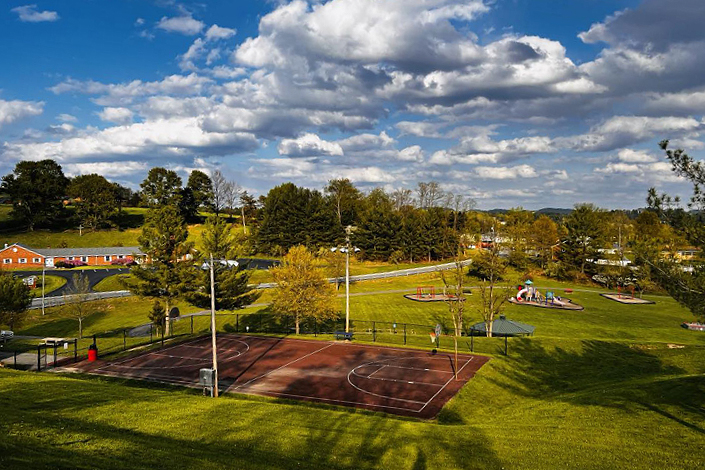West Virginia Industries Build a Stronger Future
By Paige Udermann

Broadband
Broadband has been a central topic of conversation throughout West Virginia for many years. Its lack of development has stunted the growth of numerous communities, limiting opportunities for both people and businesses. However, a historic expansion of broadband is underway in the state according to Kelly Workman, director of the West Virginia Office of Broadband. This exciting advancement includes investments by many pivotal federal programs, one being the American Rescue Plan Act (ARPA).
There are currently 42 ARPA broadband projects progressing across 40 counties in the Mountain State.
“Every project is important to us because each represents another West Virginia community gaining access to this essential technology,” Workman says.
Securing resources is a critical aspect of expanding broadband. West Virginia became one of the first states in the nation to gain approval for its proposal to the Infrastructure Investment and Jobs Act (IIJA) Broadband Equity Access and Deployment (BEAD) program, securing $1.2 billion in BEAD funds.
In addition, local governments and private companies are also investing in broadband infrastructure. Many local governments have even included broadband in their development strategies, and private companies are investing in local communities.
“Our approach has been to establish broadband as a target industry,” Workman says. “In the same way we work to attract automotive investment in West Virginia, for example, we have worked to create a business environment that attracts and supports investment and expansion by the broadband industry.”
 A more connected West Virginia supports all other economic development initiatives, driving the state forward and laying the foundation for sustainable growth.
A more connected West Virginia supports all other economic development initiatives, driving the state forward and laying the foundation for sustainable growth.
“Broadband alone is not the cure-all,” says Michael Graney, executive director of the West Virginia Department of Economic Development. “However, it has to be an integral component of the state’s long-range economic development strategy, and it’s essential for competing in the local, national and global economies.”
Construction
The construction industry plays a vital role in infrastructure development, job creation and economic growth. Although challenges of workforce recruitment and retention are prevalent, West Virginia’s construction companies continue making massive impacts throughout the state.
The state’s most significant construction projects, such as the Nucor Steel West Virginia manufacturing facility and Corridor H, show the importance of this work.
“Once completed, the $3.1 billion Nucor manufacturing facility in Apple Grove will be one of the largest vertical construction projects ever completed,” says Jason Pizatella, CEO of the Contractors Association of West Virginia.
“As of today, there are over 1,000 contractors working to build the new steel mill and related improvements in Mason County.”
The remarkable economic implications of this project are historic, with both short- and long-term benefits for West Virginians. Corridor H also continues to make its mark as the state’s largest highway project.
“The Kerens to Parsons segment is now fully under construction, and by summer 2025, motorists will be able to drive nonstop from Weston to Parsons,” Pizatella says. “Design work on the Parsons to Davis segment, and from Wardensville to the Virginia state line, is well underway. Unfortunately, the segments yet to be constructed, especially Parsons to Davis, are in some of the most environmentally sensitive terrain in all of West Virginia. Nonetheless, a final completion date for this critically important highway is in sight.”
According to Pizatella, the completion of these projects would not be possible without federal funding and support from the IIJA as well as public and private partnerships, which are also significant factors in accomplishing these groundbreaking projects.
Water
Fresh water is essential for thriving communities, yet many of West Virginia’s water treatment plants and distribution networks were built decades ago. This raises concerns about the aging infrastructure. The wear and tear is evident in issues like leaking pipes and waterline breaks, with rural communities facing the greatest
challenges.
To address these issues, many critical water infrastructure projects are working to provide necessary updates and new construction.
“All the water and wastewater projects currently under construction are vital to our communities,” says Marie Prezioso, executive director of the West Virginia Water Development Authority (WDA). “These projects will improve drinking water quality, provide service to new customers, protect public health and encourage economic growth.”
State and federal funding are being used to keep the momentum moving forward.
“The West Virginia Economic Enhancement Grant Fund (EEGF) was established in April 2022 by the West Virginia Legislature through HB 4566, which authorized the creation of the EEGF to grant funds to governmental agencies or not-for-profits for the purpose of funding water, wastewater, stormwater, economic development and tourism projects,” Prezioso says.
The West Virginia WDA has funded 161 projects across 49 counties and works in partnership with federal and state funding agencies to make the EEGF an effective program with a lasting impact.
 Looking ahead, climate resilience is becoming a priority in water infrastructure planning.
Looking ahead, climate resilience is becoming a priority in water infrastructure planning.
“All new water and sewer projects requesting public funding are designed with standards that take flood areas into consideration,” Prezioso says. “Systems that were damaged by flooding are being rebuilt to mitigate any future issues.”
With continued investment and a focus on long-term sustainability, these infrastructure improvements will help make sure West Virginians have safe, reliable water access for years to come.
Manufacturing
As infrastructure improves in other sectors, like broadband and new construction, manufacturing begins to propel forward. It is a symbiotic relationship—investments in one industry help existing manufacturers and strengthen West Virginia’s ability to attract new business.
Revolutionary manufacturing projects are in development in the Mountain State.
“Our three largest manufacturing projects are Nucor near Point Pleasant, which will produce recycled steel; TIMET in Ravenswood, which will manufacture titanium; and Form Energy, which creates large-scale batteries for utilities in Weirton,” says Bill Bissett, president of the West Virginia Manufacturers Association. “While these new companies represent tremendous new investments in the Mountain State, it is important that we remember the many manufacturers of all sizes located here that produce necessary products and are vital to both our economy and our modern way of life.”
As manufacturing across West Virginia sees massive growth, it is necessary to consider the many associated developments, such as workforce. Although workforce remains a challenge, Bissett believes West Virginia is on the right track, acknowledging the problem and working tirelessly toward a solution. Toyota Motor Manufacturing West Virginia, for example, offers development programs beginning in high school aimed to result in gainful employment.
“We continue to look for ways to remove any impediments to gainful employment, which is why we continue to look for solutions related to child care, transportation and helping those individuals who have completed drug treatment find their way to a good job, which is also an important component to their ongoing success,” Bissett says.
Broadband is another development that must improve alongside manufacturing.
“I believe broadband deployment is a resource that we must have to compete economically,” Bissett says. “While it benefits our lives in many other ways, our companies must be able to communicate and share information to be successful.”
Moreover, roadways like Corridor H and proper maintenance of infrastructure are paramount in benefiting the manufacturing industry.
 Due to new infrastructure investments, many opportunities are arising in the digital industries, including data centers, cybersecurity and artificial intelligence.
Due to new infrastructure investments, many opportunities are arising in the digital industries, including data centers, cybersecurity and artificial intelligence.
“As a historic energy state, I would suggest that this digital technology is manufacturing, as much of commerce, health care, education and other areas of our lives are dependent on this technology,” Bissett says. “As this investment in data centers grows, West Virginia can be well positioned as long as we have the right infrastructure to welcome them.”
Aviation
West Virginia’s aviation industry is making major infrastructure developments. Airports play an integral role in supporting the state’s overall infrastructure strategy as they facilitate connectivity and drive economic growth.
“Air travel is essential for existing businesses as well as companies looking to locate in the Mountain State,” says Nicolas Diehl, president of the West Virginia Airport Managers Association and CEO of the Eastern West Virginia Regional Airport. “It is also an important quality of life indicated for our residents and those who may be considering relocating to Almost Heaven.”
West Virginia’s 27 airports contribute significantly to the state’s economy, supporting nearly 12,000 jobs and generating more than $3.5 billion in economic impact. Beyond travel, the aviation industry also strengthens aviation education through multiple growing flight schools and serves as a training location for the military, including being the home base for the West Virginia Air National Guard.
Infrastructure improvements are underway at nearly every airport in the state, with funding primarily coming from the Federal Aviation Administration’s Airport Improvement Program, supplemented by state, public and private contributions.
One notable project is the renovation of West Virginia International Yeager Airport (CRW).
“CRW is undergoing a terminal development project called CRW Next, which involves significant upgrades to improve passenger experience, streamline security and enhance operational efficiency,” says Andrew Gunnoe, chief development officer and assistant director at CRW. “CRW is simultaneously undertaking a General Aviation Apron Expansion. A $5.1 million project to expand the general aviation apron is underway, aiming to improve operational capacity and support increased aviation activities.”
 CRW is not the only airport expanding. North Central West Virginia Airport is nearing completion of a $54 million terminal expansion, including a new terminal building, expanded land and modernized facilities. Morgantown Municipal Airport is also in the midst of a runway extension project that will lengthen the runway to 6,200 feet. Diehl says this will allow for larger aircraft and increased flight options.
CRW is not the only airport expanding. North Central West Virginia Airport is nearing completion of a $54 million terminal expansion, including a new terminal building, expanded land and modernized facilities. Morgantown Municipal Airport is also in the midst of a runway extension project that will lengthen the runway to 6,200 feet. Diehl says this will allow for larger aircraft and increased flight options.
With continued investment in modernization and expansion, aviation infrastructure projects will promote growth, travel and overall economic well-being in the state.
Housing
People are the driving forces behind economic progress, and those people need adequate, affordable places to live. Housing infrastructure is essential in fostering a resilient, dedicated workforce.
As barriers to new housing, like broadband and water, are being addressed, many exciting projects are taking place to improve housing.
“The Putnam County Development Authority is developing more than 600 new homes in Hurricane and Fraziers Bottom,” says Kevin Roberts, president of the Home Builders Association of West Virginia. “Heritage Housing, an affordable housing developer, renovated Chapmanville Towers in Chapmanville, and a housing project in Rupert is being completed.”
These are three of the many housing projects occurring throughout the state, yet it still faces affordable housing shortages. To assuage this hurdle, West Virginia has a plan.
“The state is offering several incentives for contractors and developers to produce developments such as tax incentives and infrastructure rebates,” says Roberts. “The state has launched a program called BUILD WV, which offers several incentives. These include a sales tax exemption on the purchase of building materials, tangible personal property and services directly used in the construction of a certified BUILD WV project by a construction contractor or subcontractor. There is also a Property Value Adjustment Credit, which can be applied against the personal or corporate income tax of the eligible taxpayer. Additionally, there is the potential for a business and occupation tax exemption, which is determined by individual municipalities or authorities through an ordinance.”
 Between the ongoing housing projects and strategic incentives, West Virginia is working to meet the growing demand for affordable housing. The state needs the essential infrastructure to not only survive but thrive and create economic prosperity for the Mountain State and its people.
Between the ongoing housing projects and strategic incentives, West Virginia is working to meet the growing demand for affordable housing. The state needs the essential infrastructure to not only survive but thrive and create economic prosperity for the Mountain State and its people.








